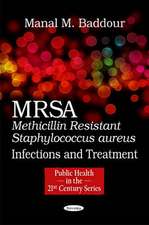Handbook of Sepsis
Editat de W. Joost Wiersinga, Christopher W. Seymouren Limba Engleză Paperback – 25 apr 2018
nal in scope, with contributions from leading experts worldwide. It will be of value to residents and professionals/practitioners in the fields of infectious diseasesand internal medicine, as well as to GPs and medical students.
Preț: 720.03 lei
Preț vechi: 757.92 lei
-5% Nou
Puncte Express: 1080
Preț estimativ în valută:
137.82€ • 149.75$ • 115.84£
137.82€ • 149.75$ • 115.84£
Carte tipărită la comandă
Livrare economică 16-22 aprilie
Preluare comenzi: 021 569.72.76
Specificații
ISBN-13: 9783319735054
ISBN-10: 3319735055
Pagini: 190
Ilustrații: VIII, 267 p. 22 illus., 19 illus. in color.
Dimensiuni: 155 x 235 x 17 mm
Greutate: 0.54 kg
Ediția:1st ed. 2018
Editura: Springer International Publishing
Colecția Springer
Locul publicării:Cham, Switzerland
ISBN-10: 3319735055
Pagini: 190
Ilustrații: VIII, 267 p. 22 illus., 19 illus. in color.
Dimensiuni: 155 x 235 x 17 mm
Greutate: 0.54 kg
Ediția:1st ed. 2018
Editura: Springer International Publishing
Colecția Springer
Locul publicării:Cham, Switzerland
Cuprins
PART 1. SEPSIS: AN OVERVIEW:.-1. What is sepsis?.- 2. The epidemiology of sepsis.- PART 2. THE PATHOGENESIS OF SEPSIS:.- 3.The pathogenesis.- 4.The coagulation system in sepsis.-5.The endocrine system in sepsis.- 6.Biomarkers for sepsis.- PART 3.SEPSIS MANAGEMENT:.- 7.International clinical practice guidelines.- 8. Fluids.- 9.Vasopressors.- 10. Multiorgan failure.- 11.Importance of the pathogen.- 12.Antimicrobial therapy.- 13.Adjunctive immunotherapy.- PART IV. SEPSIS IN THE COMING DECADE:.- 14.Novel trial design in sepsis.- 15. Sepsis in low- and middle income countries.- 16 Sepsis: the road ahead.
Recenzii
“The purpose is to help both clinicians and laboratory scientists better understand the pathogenesis of sepsis and its management. This is a worthy goal and this book meets its objective of clearly explaining this complex topic. … This is a high-quality resource that does an excellent job of simplifying a complex topic. It is a valuable resource for professionals/practitioners and anyone who desires to study sepsis in depth.” (John M Horne, Doody's Book Reviews, March, 2019)
“This book provides the reader with the context on which sepsis care has been built, a review of current management, as well as a discussion of future trends. It would be a welcomed addition to a bookshelf of any trainee, health professional, or basic/clinical researcher who seek to immerse themselves into this complex and well-studied disease entity. It is concise and lends itself as an excellent, yet intimate, introduction into this vast topic area.” (Vatsal Trivedi and Manoj M. Lalu, Anesthesia & Analgesia, Vol. 128 (2), February, 2019)
Notă biografică
Dr. Wiersinga is Professor of Medicine and chief of the Division of Infectious Diseases at the Department of Internal Medicine, Academic Medical Center, Amsterdam. In addition, he serves as clinical lecturer for biomedical science and medicine studies, and Principal Investigator at the Center for Experimental Molecular Medicine (CEMM), University of Amsterdam. His research centers on the pathogenesis of sepsis with a special interest in pneumonia, melioidosis and the gut microbiome. He is member of several guidelines on the management of patients with pneumonia and sepsis. Parameters of esteem include the ESCMID Young Investigator Award, the O'Callaghan PhD award and the Australian and New Zealand Intensive Care Society (ANZICS) Intensive Care Global Rising Star Award. He coordinates the EU Marie Curie ITN European Sepsis Academy.
Dr. Seymour is an Assistant Professor in the Departments of Critical Care, Emergency Medicine, and Clinical and Translational Science at the University of Pittsburgh School of Medicine. He is a core faculty member in the Clinical Research and Systems Modeling of Acute Illness (CRISMA) Center. Over the past 5 years, he has led numerous clinical and translational studies involving sepsis, biomarkers, and large electronic health record databases and received funding for his research from the National Institutes of Health. He has served on international clinical guideline committees and panels that focus on the definition and management of sepsis. Among many accolades, he has received early career investigator awards from the American Thoracic Society and the Australian and New Zealand Intensive Care Society (ANZICS) Intensive Care.
Dr. Seymour is an Assistant Professor in the Departments of Critical Care, Emergency Medicine, and Clinical and Translational Science at the University of Pittsburgh School of Medicine. He is a core faculty member in the Clinical Research and Systems Modeling of Acute Illness (CRISMA) Center. Over the past 5 years, he has led numerous clinical and translational studies involving sepsis, biomarkers, and large electronic health record databases and received funding for his research from the National Institutes of Health. He has served on international clinical guideline committees and panels that focus on the definition and management of sepsis. Among many accolades, he has received early career investigator awards from the American Thoracic Society and the Australian and New Zealand Intensive Care Society (ANZICS) Intensive Care.
Textul de pe ultima copertă
This practically oriented book provides an up-to-date overview of all significant aspects of the pathogenesis of sepsis and its management, including within the intensive care unit. Readers will find information on the involvement of the coagulation and endocrine systems during sepsis and on the use of biomarkers to diagnose sepsis and allow early intervention. International clinical practice guidelines for the management of sepsis are presented, and individual chapters focus on aspects such as fluid resuscitation, vasopressor therapy, response to multiorgan failure, antimicrobial therapy, and adjunctive immunotherapy. The closing section looks forward to the coming decade, discussing novel trial designs, sepsis in low- and middle-income countries, and emerging management approaches. The book is international in scope, with contributions from leading experts worldwide. It will be of value to residents and professionals/practitioners in the fields of infectious diseases and internal medicine, as well as to GPs and medical students.
Caracteristici
Provides up-to-date information on the management of sepsis, including within the intensive care unit Explains the use of biomarkers in the diagnosis and treatment of sepsis Assists in the optimal use of antimicrobial therapy and adjunctive immunotherapy Includes contributions from leading experts across the world















